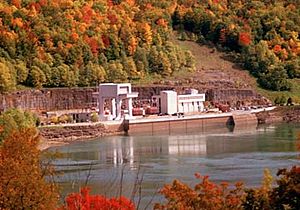Blenheim–Gilboa Hydroelectric Power Station facts for kids
Quick facts for kids Blenheim–Gilboa Hydroelectric Power Station |
|
|---|---|
 |
|
| Country | United States |
| Location | Blenheim / Gilboa, Schoharie County, Catskill Mountains, New York, USA |
| Coordinates | 42°27′18″N 74°27′29″W / 42.45500°N 74.45806°W |
| Owner(s) | NYPA |
| Reservoir | |
| Total capacity | 19,000,000 m3 (5.0×109 US gal) |
| Power station | |
| Installed capacity | 1,134 MW (1,521,000 hp) |
The Blenheim–Gilboa Pumped Storage Power Station is a special kind of power plant located in the Catskill Mountains of New York State. It's like a giant battery that stores energy using water. This plant is part of the New York Power Authority and can create over 1,100 megawatts of electricity. It is used every day to help meet the highest electricity needs, known as peak demand.
The plant uses two large reservoirs. Both can hold about 19 million cubic meters of water. One reservoir is at the bottom of Brown Mountain in the Schoharie Valley. The other is at the top of the mountain. The power station can store about 12,000 megawatt-hours of energy.
How the Power Plant Works
The lower reservoir was made by building a dam on the Schoharie Creek. Water from this lower reservoir is pumped up the mountain through a large concrete shaft to the upper reservoir. This happens when there is extra electricity available, usually at night. The water is stored there until it is needed.
When people need a lot of electricity, the water is released from the upper reservoir. It flows back down the mountain into the lower reservoir. On its way down, the water enters a power plant building. Inside, it spins large machines called turbines. These turbines are connected to generators that make electricity. The power plant building was built in 1973. It has four special units that can both pump water up and generate electricity.
After the water spins the turbines, it flows back into the lower reservoir. Then, it goes over the dam and continues down the Schoharie Creek. Between 2003 and 2010, the machines were updated to be even more powerful. The plant is very efficient, meaning it uses most of the energy it stores.
Blenheim–Gilboa Visitors Center
The Blenheim–Gilboa Visitor Center is a fun place to learn about energy. It is located in an old dairy barn from the 1700s. Inside, you can find exhibits and interactive displays. These shows explain how energy and electricity are made and used. It's free to visit the center.
Next to the Visitor Center is the historic Lansing Manor House. This old house is now a museum. Both the Visitor Center and the power project are close to Mine Kill State Park.
See also
- List of power stations in the United States
- List of reservoirs and dams in New York
- New York energy law

